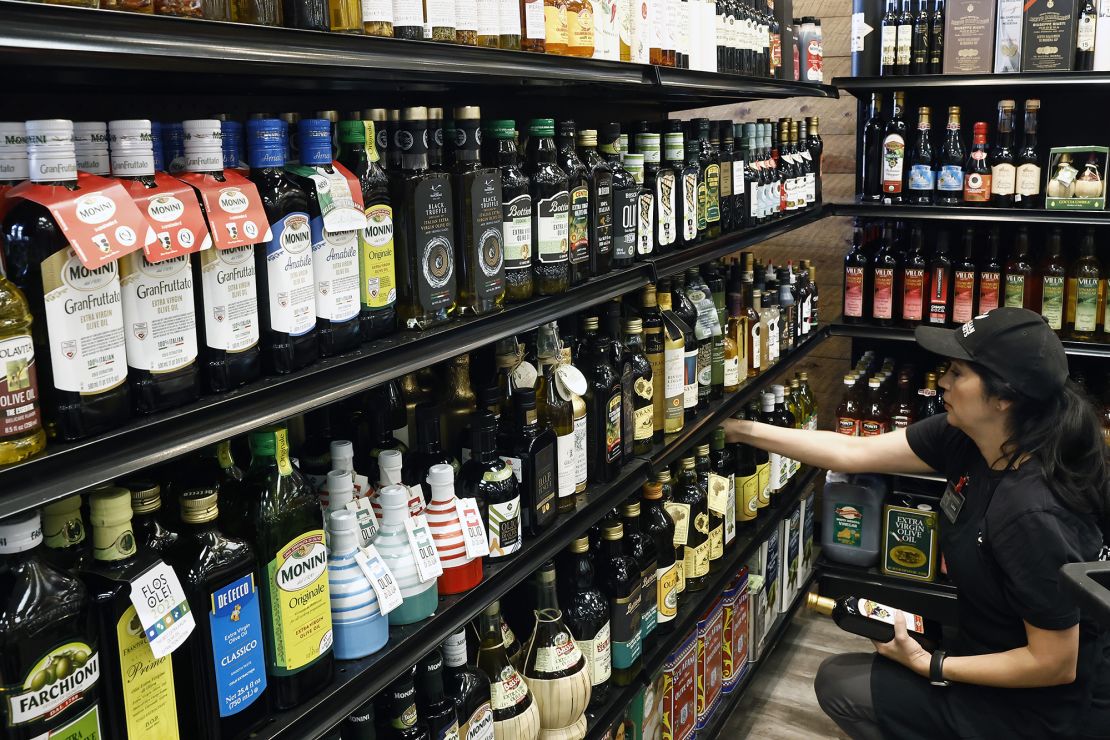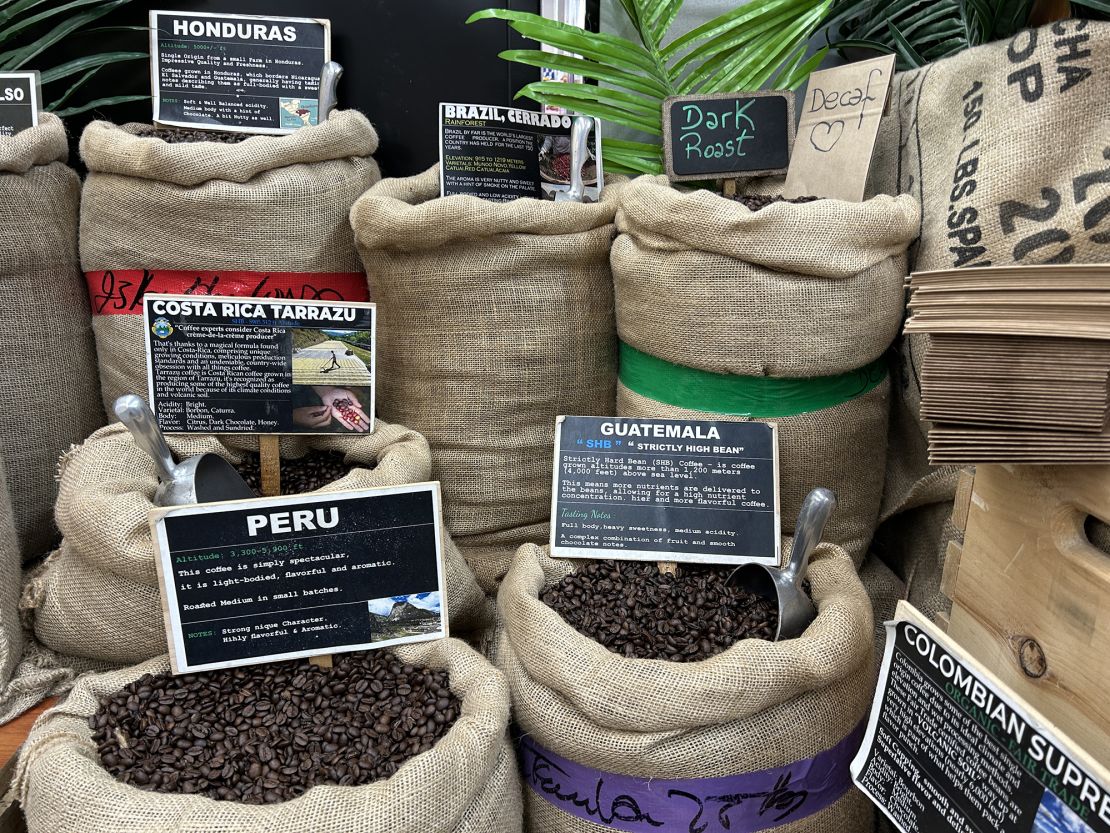new York
Cnn
–
President Donald Trump, during his announcement last week of sweeping prices on the countries of the world, described the grocery store as “old -fashioned term” and “beautiful term”. But its policies will make the American grocery store more expensive today, according to supermarket leaders and experts in the food industry.
Supermarkets sell items imported in all sections of the store: fresh and wrapped food at household bases. Trump instituted 10% tariffs in all countries last Saturday and sorted higher reciprocal prices in 60 countries and commercial blocks today. American companies for shipping goods abroad will pay for these prices, and they will reduce some of the higher costs to consumers.
Buyers can expect to see prices increase on seafood, coffee, fruit, cheese, nuts, candy bars and other imported foods, according to experts. Articles that contain ingredients and packaging such as plastic and aluminum from other countries will also be affected. The prices of perishable food will increase first, followed by stable goods. Customers can also see small products, known as the narrowing, and note that certain versions of items have been eliminated while businesses are trying to compensate for their tariff cost increases.
Customers can expect the prices of the grocery store to increase “over the next two weeks,” said John Ross, CEO of IGA, An independent grocery chain. “Buyers will start to see it on a large scale in the store in the next 90 days.”
Food prices will increase in all 2.8% compared to Trump prices, including 4% for fresh products, estimates from the Budget laboratory at the University of Yale. The cost burden will strike low -income buyers, who will spend a larger share of their essentials, the most difficult.
The extent of price increases will also depend on the size of companies.
The prices of small grocers, which have less flexibility to absorb higher costs than giant channels like Walmart and Costco, can increase more quickly. Large food suppliers such as Campbell and Kraft Heinz also have more flexibility to manage prices than small producers. But few companies will be spared effects.
“It seems that small distributors react much faster,” said Steve Schwartz, sales and marketing director of the Morton Williams grocery chain. Small distributors have less offer at hand and will first increase prices, while large companies with more inventory in warehouses can wait longer, Schwartz said.
For example, an Italian importer that provides olive oil and balsamic vinegar informed Morton Williams of a price increase of 20% next month.

Randy Arceneaux, the CEO affiliated Foods, a wholesaler in Amarillo, Texas, with 700 independent grocery stores in eight states, said most suppliers were still waiting to see what is going on with prices.
But this is not the case for all the suppliers of Food Affiliated Food – Several has already informed the company of price increases due to prices, in particular bananas and canned tuna, as well as plastic utensils.
Affiliated foods deepens guatemala bananas, where Trump has implemented a tariff of 10%. The distributor Affiliated Foods’ informed the company that an increase in prices of 10% will come into force next week.
This will increase the costs of affiliates affiliated with 4 cents per banana, from $ 1.80 to $ 1.84, which will be passed on to buyers.
The foods that Americans eat are part of a complicated global supply chain, a large part of growth that is impossible to reproduce in the United States due to climatic conditions and cultures. Food that cannot be cultivated locally will see the largest price increase.
Currently, the United States is about 17% of all foods and drinks consumed by Americans, but it varies considerably depending on the category. For example, around 80% of seafood, 80% of coffee, 59% of fresh fruit and 35% of vegetables consumed in the United States are imported, according to the Ministry of Agriculture.

“Our food system is complex linked to global markets – including unclear products in the United States such as bananas or seasonal items – which helps reduce prices while providing American buyers with safe and nutritious foods,” said Leslie Sarasin, president of the FMI food industry, last week.
But a major factor that could limit price increases is that Mexico and Canada have been left aside Trump’s latest list of prices. Mexico and Canada are the two largest agricultural suppliers in the United States, according to the Department of Agriculture.
The White House has slapped 25% of prices on these countries, but most food and agricultural products are exempt from prices under the USMCA free trade agreement between the United States, Mexico and Canada.
The prices of the grocery store have already frustrated customers before the prices. Trump said he won the 2024 elections largely due to the price of the grocery store.
The prices of the whole grocery store have increased by around 23% since 2021, the prices of individual items such as coffee and chocolate increasing much faster.
This had buyers removed. Pepsico, Campbell and JM SMUCKER have reported weak sales of their snack brands in the recent announcements of the results, and the prices will probably only accelerate the slowdown.
Pepsico, the owner of Froto-Lay, said last month that people had bought 3% snacks in less quarter in the last quarter.
“The categories of savory and salty snacks have underperformed” to the wider wrapped food industry, said Pepsico, citing the “cumulative impacts of inflationary pressures and higher borrowing costs on consumer budgets”.
Household staples, such as dishwashing detergents, paper towels and cosmetics, have also experienced a slowdown in recent weeks, according to the market for market research Circana.
“Some consumers are moving away from discretionary expenses” at the grocery store, said Sally Lyons Wyatt, chief advisor to Circana for consumer goods industries and food services.
More and more buyers are making faster and smaller trips to stores and go to brands of cheaper private brands, she said. These are signs that customers watch their budgets more carefully.
Customers “always show that the desire to spend, but they are very chosen where they spend,” said Costco Finance chief Gary Millerchip last month.


